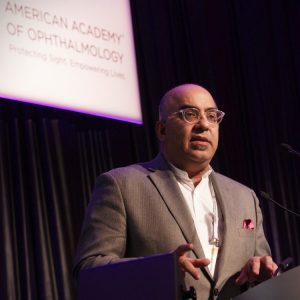Crisis sparks online growth

Dermot McGrath
Published: Tuesday, September 1, 2020
 Ken K. Nischal MD, FRCOphth
Ken K. Nischal MD, FRCOphthThis weekend's WSPOS World Wide Connect meeting will allow delegates from all over the globe connect with the WSPOS online congress.
With tele-ophthalmology already gaining traction in recent years as an effective eyecare delivery modality worldwide, the COVID-19 pandemic has served to further amplify this trend, according to Ken K. Nischal MD, FRCOphth.
In a special webinar (https://youtu.be/8MDKupy6xhA) organised by the World Society of Paediatric Ophthalmology and Strabismus (WSPOS), Dr Nischal, Chief of the Division of Paediatric Ophthalmology, Strabismus, and Adult Motility at the UPMC Children’s Hospital of Pittsburgh, United States, outlined some of the key features and benefits of a tele-ophthalmology service for paediatric patients.
“The future is here. I do not think that tele-ophthalmology is going to go away and we would be well advised to become familiar with it as we seek to make the best use of the resources we have available to us in caring for our patients in the current crisis,” he said.
Tele-ophthalmology services can be provided primarily in two ways – synchronously or asynchronously, explained Dr Nischal.
Synchronous tele-ophthalmology enables real-time interaction between participants for consultations using standard telemedicine technologies such as video-conferencing.
“The clinic usually sets up the appointment at a designated time, or the patient may have 24/7 on-demand access to a carer. The carer is not necessarily an ophthalmologist – for instance it is a paediatrician who will handle the demands in the AnywhereCare system used at Pittsburgh,” he said.
More familiar to most ophthalmologists is asynchronous tele-ophthalmology, the classic “store-and-forward” method, where data is captured by the patient and transmitted for review at a later time.
“For instance, we get parents sending us pictures of their child’s eye for retinopathy of prematurity (ROP) or diabetic retinopathy (RP). We also use it to garner opinions from patients and other doctors,” he said.
Implementing an effective synchronous tele-ophthalmology service can be challenging, explained Dr Nischal.
“You obviously need a certain amount of equipment in terms of the video platform, bandwidth etc. You also need specific informed consent and declaration from parents, so that they fully understand that this is not the same as face-to-face consultation and that you have the requisite documentation to protect yourself. It is a new way of interaction, so we need to remember to look at the camera when talking to the patient. It is also important to understand the clinic flow to use the resources efficiently,” he said.
Dr Nischal said that there would be a growing need for “at home” testing capability or via specialised satellite centres.
To this end, there are several applications and devices available to assist in testing and monitoring patients remotely, he said.
“For visual acuity, there are a variety of web-based or smartphone apps; for strabismus, there is the 9 Gaze app; for fundoscopy, there are smartphone adapters. We now also have a mobile device for visual field assessment which has been developed by Olleyes,” he said.